
Please note, there can be considerable variability in the detail provided by
claimants, and for this reason the data should not be presented as definitive.
• All figures are GST exclusive, and cover all treatment and entitlements
incurred for that claim, except bulk-funded services where costs are not
al ocated to individual claims. Bulk-funded services include the majority of
emergency ambulance services funding, as well as the cost of acute treatment
at public hospitals, which we bulk-fund through our $741 mil ion contribution
to Public Health Acute Services (PHAS).
• An active claim is one where a payment has been made against it in the
year shown, regardless of the year in which the claim was lodged. Some claims
have ongoing costs, so in any given year it’s likely we’l be paying costs on
claims lodged in previous years. That means, for example, that the amount we
have paid out in 2017 wil include some payments relating to injuries suffered
in 2016 or earlier, as well as those suffered in that year.
• 'New claims' have been counted by the date that a claim was lodged with
ACC. This can be immediately after the injury occurred or at any later stage.
• Data were extracted on 9 November 2023 and may differ if rerun at a
later date.
Ends
If you are not happy with this response, you have the right to make a complaint to the
Ombudsman. Information about how to do this is available at
www.ombudsman.parliament.nz or by phoning 0800 802 602.
Who
Analytics and Reporting
involved
Media enquiry
Date
Wednesday, 1 November 2023
Reporter
Amberleigh Jack
From
Stuff
9(2)(a)
Contact
Mobile:
Email: [email address]
Timefram
e
Thursday, 9 November 2023
Request
Kia ora team,
Just putting through a Hal oween data request if possible.
Can we get injury stats for Halloween injuries this year? I'm thinking pumpkin/knife as keywords
could be great on their own.
Then maybe "halloween"?
Can we also get updated stats on injuries caused by cutting avocados as a fol ow to a story we
wrote last year?
If you need anything more from me, please let me know - thank you!
Amberleigh
Media team follow-up note: We phoned Amberleigh to discuss and have agreed with her and
Analytics and Reporting to collate:
• Data on Halloween injuries 2018 – 2023
o Number and cost of claims with the accident date 31 October from 2018 – 2023
o Number and cost of claims throughout the whole month of October from 2018-
2023
o To link the word “knife” to “pumpkin carving” so that we can hopefully see a link
with Halloween injuries.
o The journalist has requested that we please include “Halloween”, “pumpkin”,
“knife” as keywords, along with any other words you suggest.
• Data on injuries caused by cutting avocados 2018 – 2023
Data
reference AR-5226
Response Kia ora Amberleigh,
Thanks again for your query.
Please find the data requested below about Hal oween injuries, and avocado related injuries along
with some explanatory notes on how this data was extracted and its limitations. Please note that a
claim may be lodged immediately following an accident or at any later stage. This means that,
given the recency of the 2023 Hal oween, these numbers may change.
We’ve also provided injury prevention tips beneath the tables. Note that the advice on staying safe
when cutting pumpkins, avocadoes or preparing other food is the same, so can be applied to either
of your stories.
Thanks
Out
of
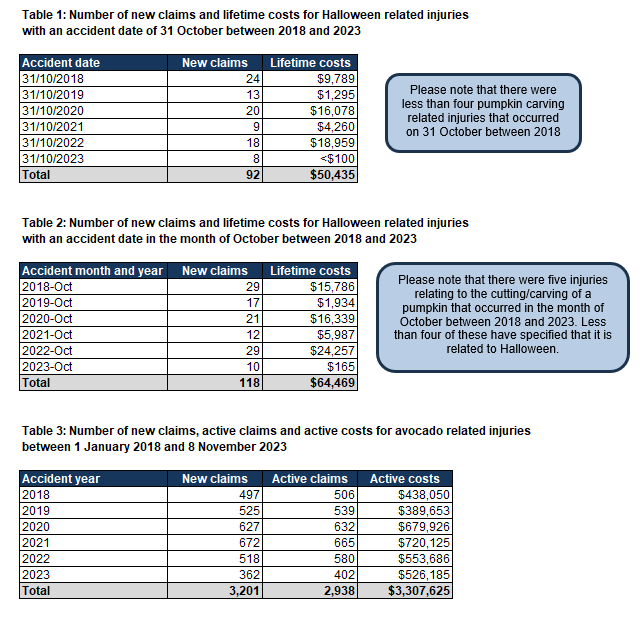 Comment from ACC’s Injury Prevention Leader, James Whitaker, on how to stay safe:
Comment from ACC’s Injury Prevention Leader, James Whitaker, on how to stay safe:
“ACC is here to help you recover from any covered injury, but it’s better for everyone if these
injuries don’t happen in the first place.
“Research indicates the vast majority of injuries are predictable and therefore preventable -
including injuries from celebrating Halloween. Injuries don’t just affect the injured person, but also
their whānau, friends and workmates.
“Injuries often happen when we rush or try to do too many things at once. If we take a moment to
slow down, and do things the safest way, we can help keep ourselves safe.”
More specifically, to prevent injuries while cutting pumpkins, avocadoes or preparing other food:
•
focus on one task at a time – thinking about the safe way to do things before getting stuck
in
•
use sharp knives so you don’t need to apply much pressure when cutting
•
place objects you are cutting on cutting boards instead of holding them in your hand
•
put your cutting board on top of a damp towel or a non-slip mat in order to prevent it
from sliding around
•
use oven mitts when handling objects that might be too hot to touch
Additional comment from James Whitaker on avocado injuries:
Each year, we get claims from people who have suffered a knife wound to their hand while taking
the stone out of the avocado. Some of these injuries can be nasty and take some time to recover
from. Avos are no more or less dangerous than anything else on the supermarket shelf. As with
most things, there are steps you can take to lessen the risk of lodging an ACC claim. If we take a
moment to slow down, and do things the safest way, we can help keep ourselves safe.
ACC supports people to recover from around 2 mil ion injuries per year and around half of these
injuries occur in people’s own homes. The number of kitchen related injuries ACC supports is more
than double the combined number of injuries linked to cricket, touch rugby, softball and tennis.
Injuries often happen when we rush or try to do too many things at once.
ENDS
Data notes and caveats:
• Please note that a claim may be lodged immediately following an accident or at any later
stage. Given the recency of the 2023 Hal oween, these numbers may change.
• The data set available to ACC is reliant on the information provided on an ACC45 injury
claim form, which is completed when a person seeks treatment for their injury. The form
has a free-text field ‘accident description’ where a person can provide a brief description
of how their accident happened. This field is not mandatory to complete and not every
client does so. Also, when the field is completed, there is considerable variation in the
way accidents are described. The data should therefore be considered indicative, but not
a definitive count of claims.
• This report counts: The number of Halloween related injuries with an accident date of 31
October and that occurred in the month of October from 2018 to 2023. These claims have
been identified where the accident description contains the words 'knife', 'knive', 'cut',
'carve', 'carved' and 'carving' with 'pumpkin', 'Halloween' and 'trick or treat'.
• Note that only accepted claims are included. Accredited employer claims have been
excluded.
• All figures are GST exclusive, and cover all treatment and entitlements incurred for that
claim, except bulk-funded services where costs are not allocated to individual claims.
Bulk-funded services include the majority of emergency ambulance services funding, as
well as the cost of acute treatment at public hospitals, which we bulk-fund through our
$741 mil ion contribution to Public Health Acute Services (PHAS).
• An active claim is one where a payment has been made against it in the year shown,
regardless of the year in which the claim was lodged. Some claims have ongoing costs, so
in any given year it’s likely we’ll be paying costs on claims lodged in previous years. That
means, for example, that the amount we have paid out in 2017 wil include some
payments relating to injuries suffered in 2016 or earlier, as well as those suffered in that
year.
• '
Active costs' are the GST exclusive cost of payments made for claims that were active in
the specified period.
• '
Lifetime costs' are the GST exclusive cost of claims with an accident date within the
specified period, and wil include payments made to date. Costs should not be compared
across years as claims may still be accruing costs and accidents that have occurred more
recently have had less time to do this.
• Data were extracted on 9 November 2023 and may differ if rerun at a later date.
Background information on ACC legislation
ACC makes claim decisions in accordance with the Accident Compensation Act 2001. The Ministry
of Business, Innovation and Employment (MBIE) is responsible for advising the Minister for ACC
on matters relating to the scheme including broader scheme direction and performance as well as
the legislation and regulations governing the scheme. For questions relating to ACC legislation,
please refer to MBIE. For questions about ACC legislation and policy, please contact:
[email address]
Complaints
If you are not happy with this response, you have the right to make a complaint to the
Ombudsman. Information about how to do this is available at www.ombudsman.parliament.nz or
by phoning 0800 802 602.
Out of scope
Who
Analytics and Reporting,
involved
Proactive media response-2021
December 24, 2021
New Ze
aland enters peak avocado injury season
Avocados have a unique place in Kiwi culinary culture, from topping the toast of millennials to their
lead role in guacamole – reportedly New Zealand’s most googled recipe for 2021.
But while the cost of avos may be dropping at the supermarket thanks to an early harvesting season,
the cost to Kiwis from avocado-related injuries is shooting up.
New figures from ACC show active claims costs for avocado injuries reached almost $680,000 in
2020, up from $392,000 in 2019.
A record 626 Kiwis lodged an avocado-related claim last year, up from just 525 in 2019 and fewer
than 500 in 2018.
Kiwis’ wrists, hands, fingers, and thumbs suffered the most, accounting for two-thirds of these
claims. The top cause of injury was ‘laceration, puncture or sting’.
As of October 31, there have already been more than 500 avocado-related claims lodged in 2021.
ACC injury prevention leader James Whitaker says most injuries were caused by “people cutting
themselves as wel as the avo”.
“Each year, we get claims from people who have suffered a knife wound to their hand while taking
the stone out of the avocado.
“Some of these injuries can be nasty and take some time to recover from.”
Figures show claims for avocado injuries increased by more than one-third in the past five years,
from 461 in 2016 to 626 in 2020.
And the figures show that on average, more than one-quarter of these injuries occur in just two
months – December and January.
Kiwis are now eating more avos than ever – industry group New Zealand Avocado reported earlier
this year sales had doubled in the past five years, from $30m in 2015 to $60m in 2020.
Research shows that 90 per cent of all injuries are preventable, and Whitaker says avocado injuries
are no different.
“Avos are no more or less dangerous than anything else on the supermarket shelf.
“As with most things, there are steps you can take to lessen the risk of lodging an ACC claim.”
ACC has recently teamed up with Wellington-based cooking school Le Cordon Bleu New Zealand to
learn more about how the next generation of Kiwi chefs keep themselves safe around avocados and
knives.
Taking your knife in your hands
So how do you safely cut an avocado? Julie Clark, founder of Wellington-based Floriditas Café and
Restaurant, uses this method:
• Stand the avocado on its end with the fatter end on the surface. Take out the smal stem if
it’s still in there
•
Hold the avocado between your thumb and forefinger and run a knife down on one side,
then turn it round and run the knife down the other side. A smal paring knife works best
• When you feel the stone, gently move the knife around it. That will give you an even cut all
the way around
• Alternatively, lie the avocado flat on its side. Place one hand on top of the avocado to hold it
steady.
• Cut around the avocado, moving it as you go
• To separate the two halves, twist them in opposite directions with your hands
• To remove the stone, gently place the tip of your knife underneath the thinner end and pop
it out - do not stab the stone with a knife
• Always use ripe avocados. Unripe avocados are the most dangerous because the stone is
very difficult to dislodge
• To remove the flesh, hold the avocado in the palm of your hand and run a large
spoon/kitchen spoon around the inner edge of the skin to scoop it out
• Put the avocado flat side down on a cutting board before cutting it
• To “fan” the avocado, cut it lengthways and gently push it to one side with the tips of your
fingers
• Slide a knife underneath the sliced avocado to transfer it to a salad, slice of toast etc
UNRIPE AVOCADOS
• If the stone does not dislodge because the avocado is not ripe enough, remove the flesh,
with the stone still in, and place stone-side down on a board
• Cut the half in even quarters to remove it from the stone
• If that does not work, remove the stone with a teaspoon. In this case, however, the avocado
is probably not ripe enough to eat
By the numbers
• ACC covered a record 626 avocado-related injuries in 2020
• As of October 31, there have been 507 avocado-related claims in 2021
• Active claims costs for 2021 stood at $553,110 as of October
• People 65 and over are the most common age-group for avocado-related injuries – between
2016 and 2020, there were 336 claims among this group
• Over-65s are the leading age-group for claims again in 2021, with 68 as of October
• Active claims costs for avocado-related injuries reached a five-year high last year of
$679,926
• Between 2016 and 2020, more than one-quarter of all avocado injuries occurred in
December and January

 Media inquiry
Media inquiry
Date
14/01/19
received
Reporter/P
roducer
Newstalk ZB
From
Rosie Gordon
Contact
[email address]
Timeframe ASAP today
Request
From: Rosie Gordon [mailto:[email address]]
Sent: Monday, 14 January 2019 1:20 PM
To: Out of scope
Subject: Avocado claims - Newstalk ZB request
Hi Lisa,
Rosie Gordon from Newstalk ZB here.
I would like to know how many New Zealanders make ACC claims over injuries involving
avocados.
I would like to know how many people have made claims including the word avocado in the
last year.
I would like to know how much these claims have cost ACC.
And any details ACC has on how these injuries happen, e.g whether people cut their hands
removing avocado stones.
I am on 9(2)(a)
My deadline is 5pm but it would be great to please have this information as soon as
possible.
Thank you,
ROSIE GORDON
REPORTER
D: 9(2)(a)
E: [email address]
_______________________
48751
Redmine #
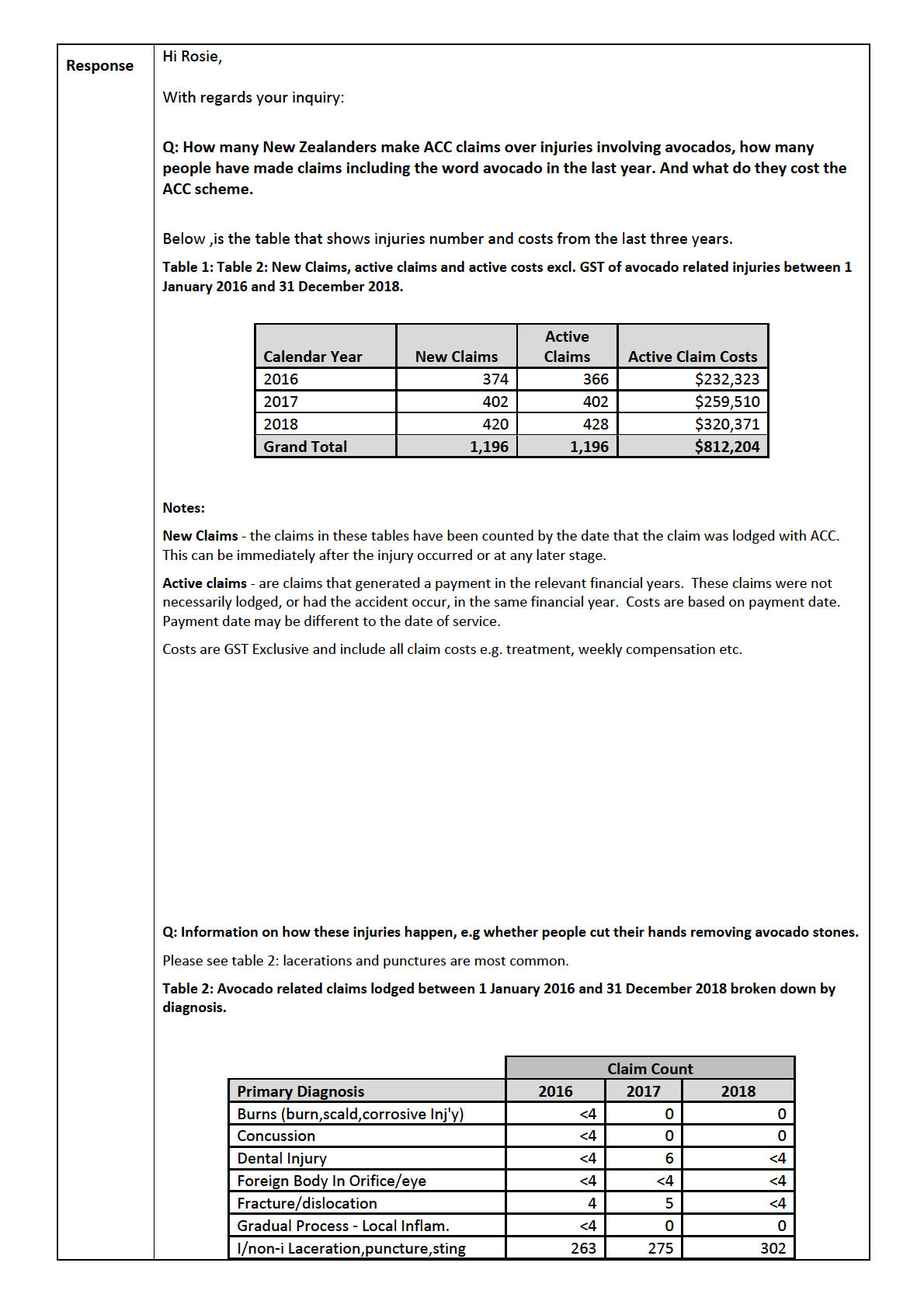
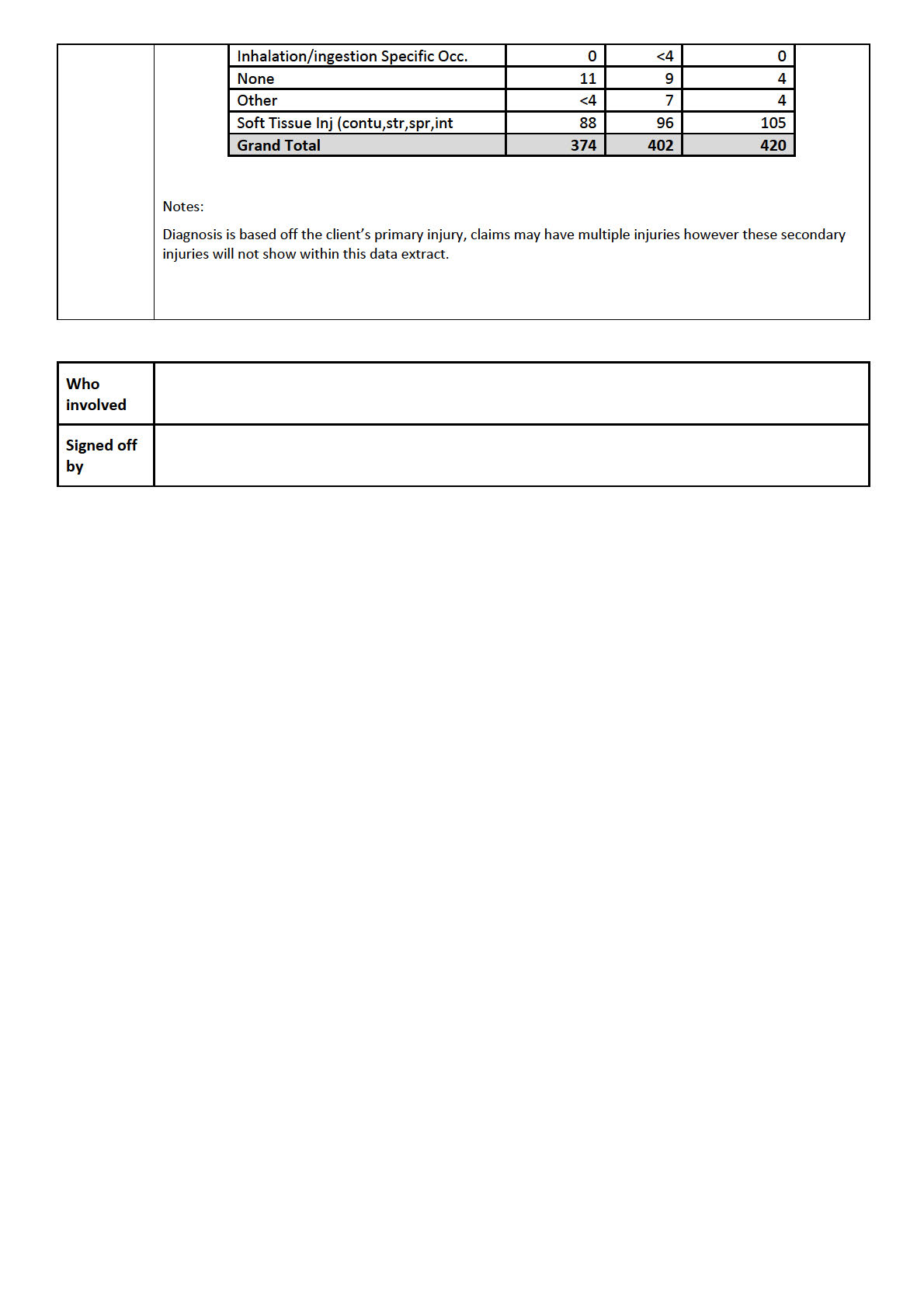
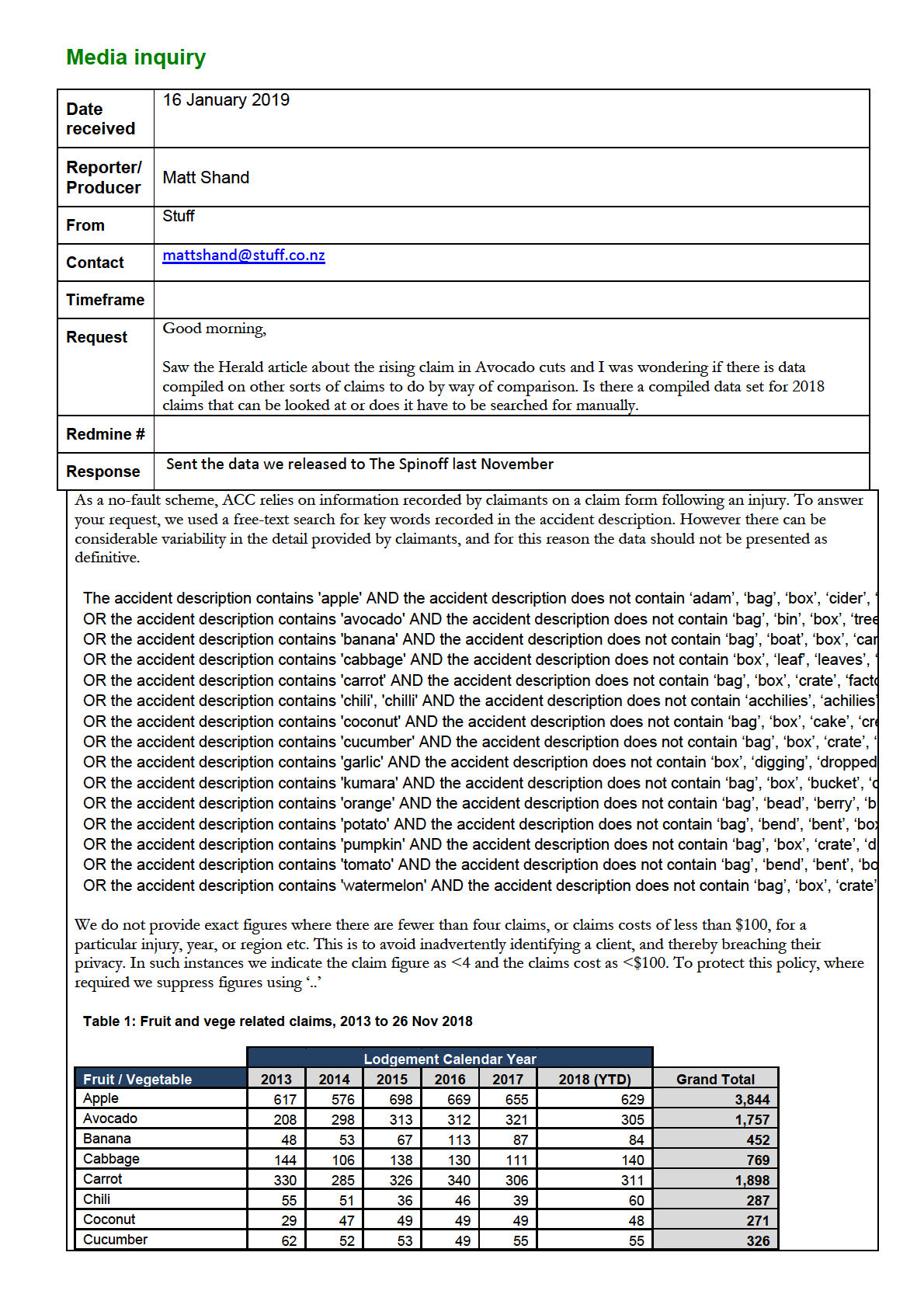
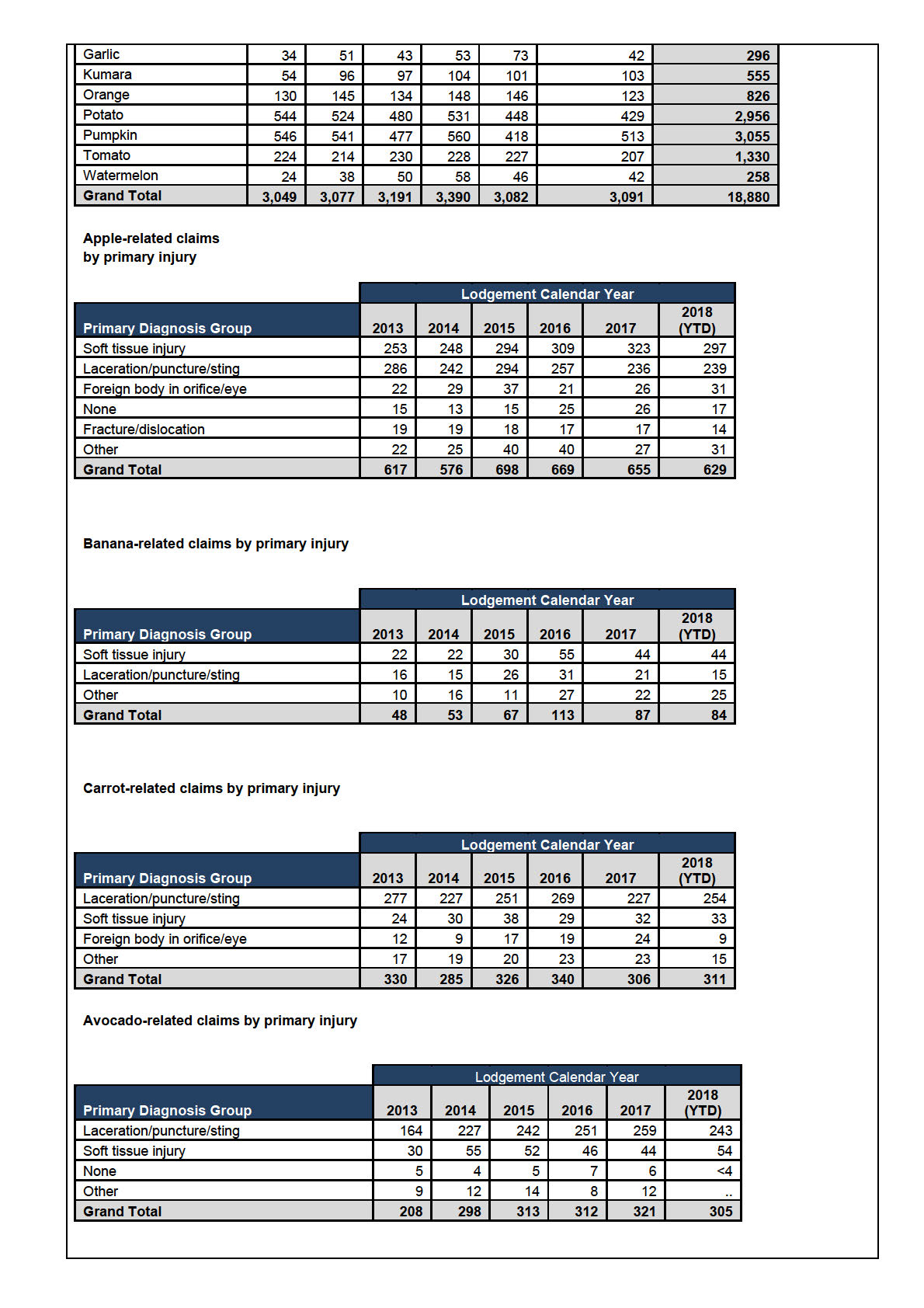
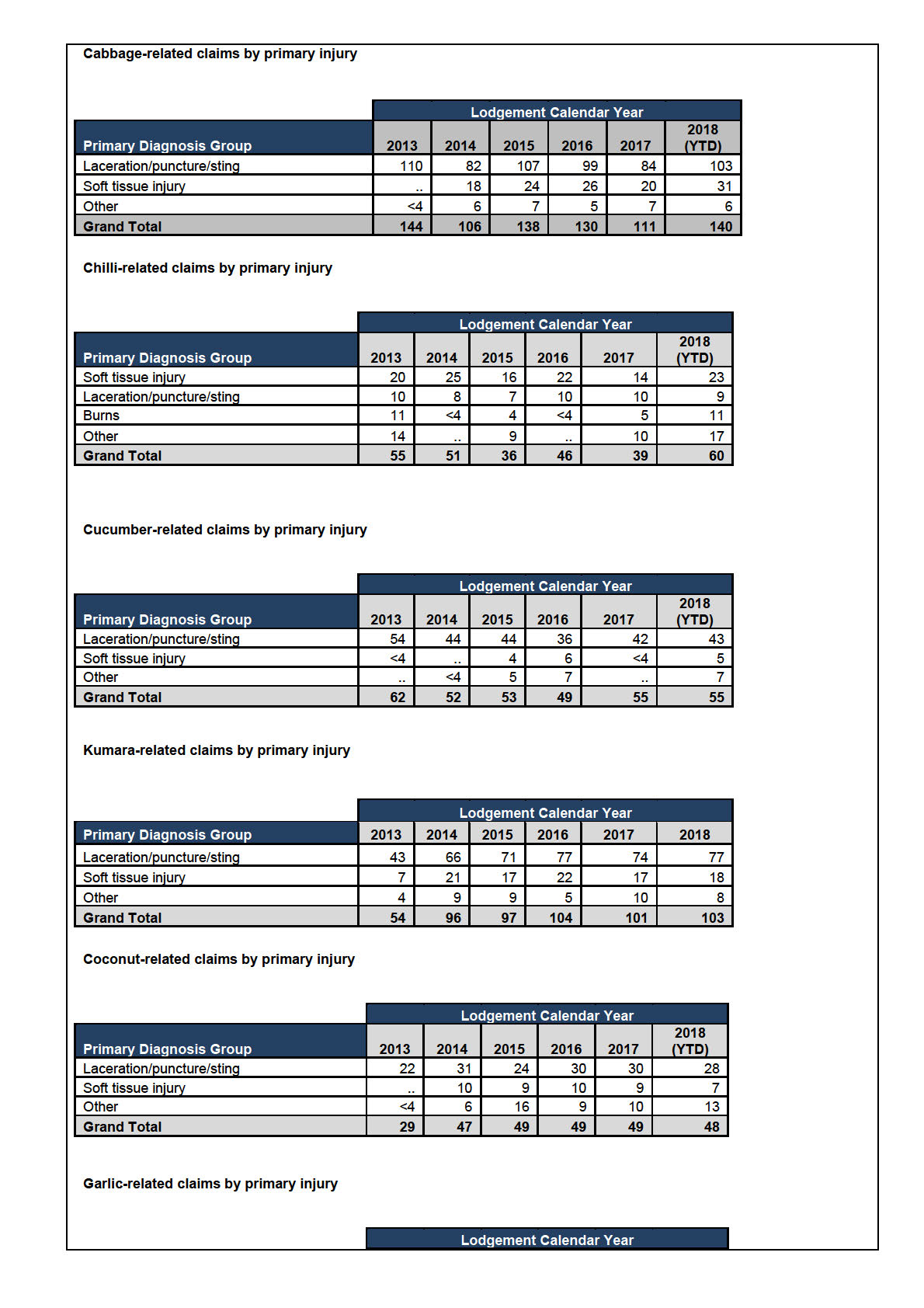

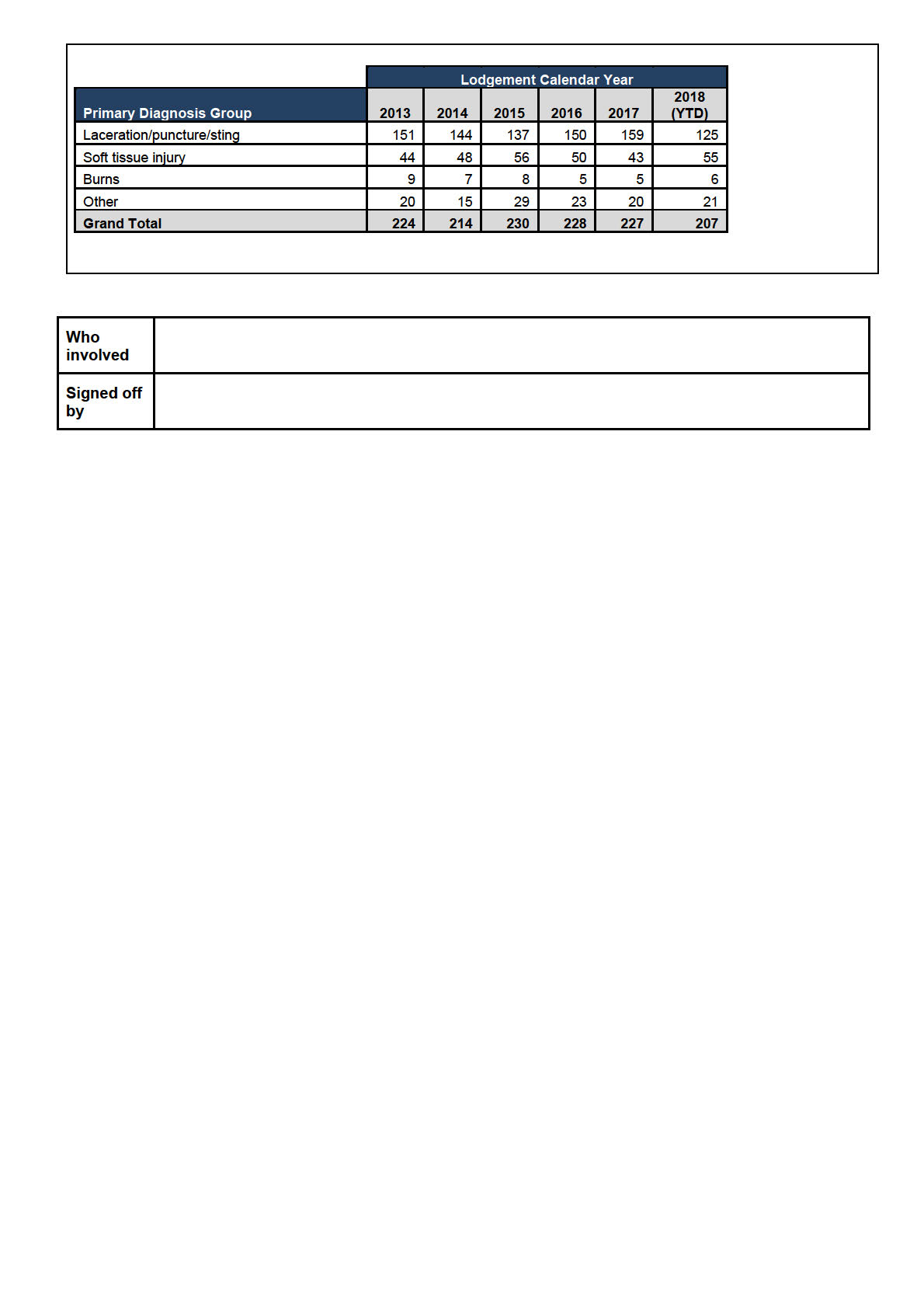
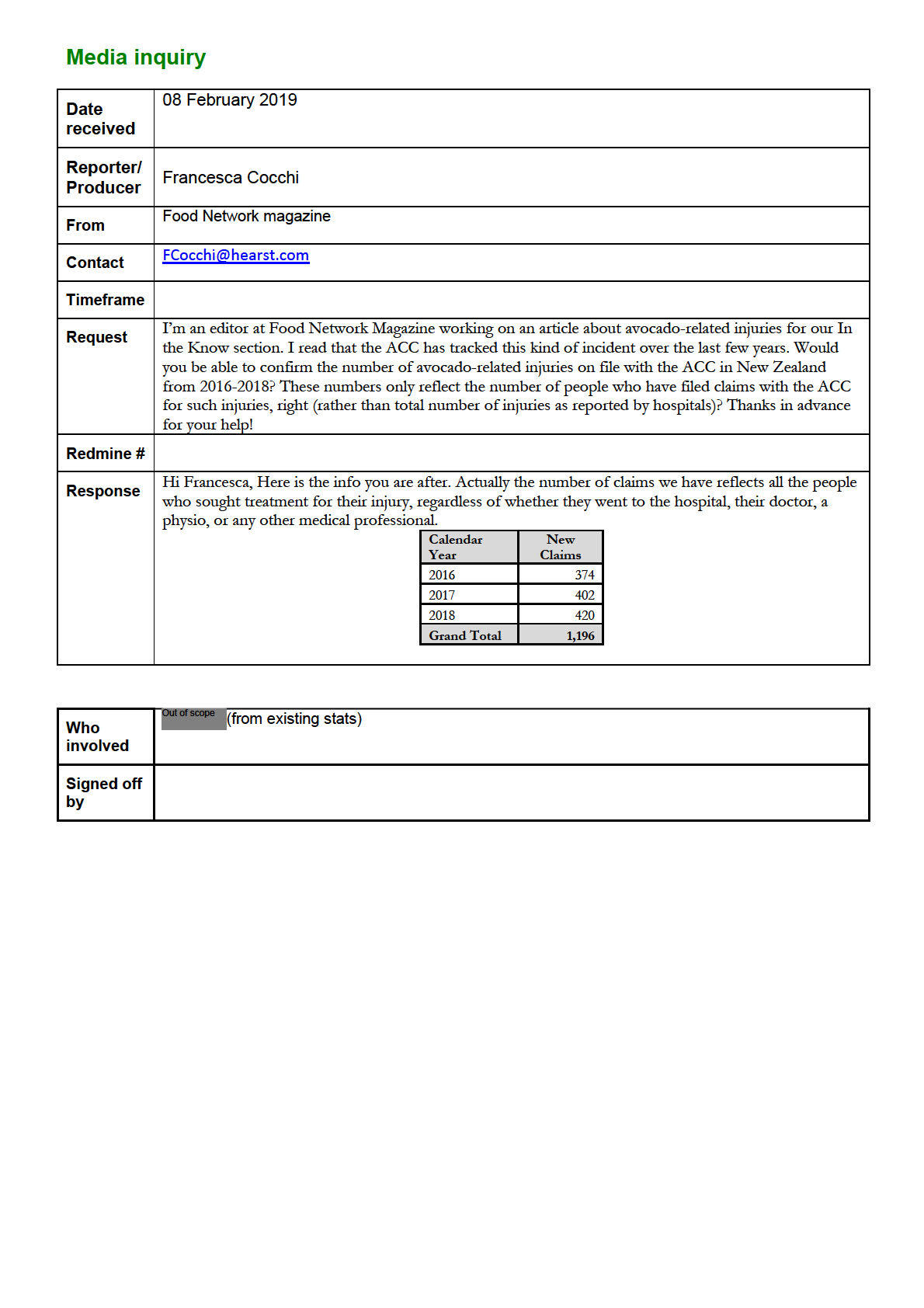
Media inquiry
Date
21 February 2019
received
Reporter/
Producer Caroline Williams
From
Stuff
Contact
Caroline.wil [email address]
Timeframe COP 22 Feb
9(2)(a)
Request
I've been in touch with a woman who suffered serious injuries,
after slipping over on a banana peel 9(2)(a)
I'm keen to see if ACC has any stats about fruit and vegetable related injuries.
Could ACC please answer the following questions, with any comments attributed to a spokesperson, by
midday Friday?
1. How many people were injured in fruit and vegetable related accidents in 2018? For example, injuries
from
- slipping on fruit and vegetables
- cutting/chopping off limbs while preparing fruit and vegetables
- getting juices from fruit and vegetables in eyes
- fruit and vegetables being inserted in bodily orifices
- projectile fruit and vegetables
- fruit and vegetables being dropped on limbs
- eating fruit and vegetables with foreign objects inside (i.e. needles in strawberries)
2. How many people died from fruit and vegetable related accidents in 2018?
3. How much did ACC spend on fruit and vegetable related accidents in 2018?
Redmine # #49110
Response We do not provide exact figures where there are fewer than four claims for a particular injury, year,
or region etc. This is to avoid inadvertently identifying a client, and thereby breaching their privacy.
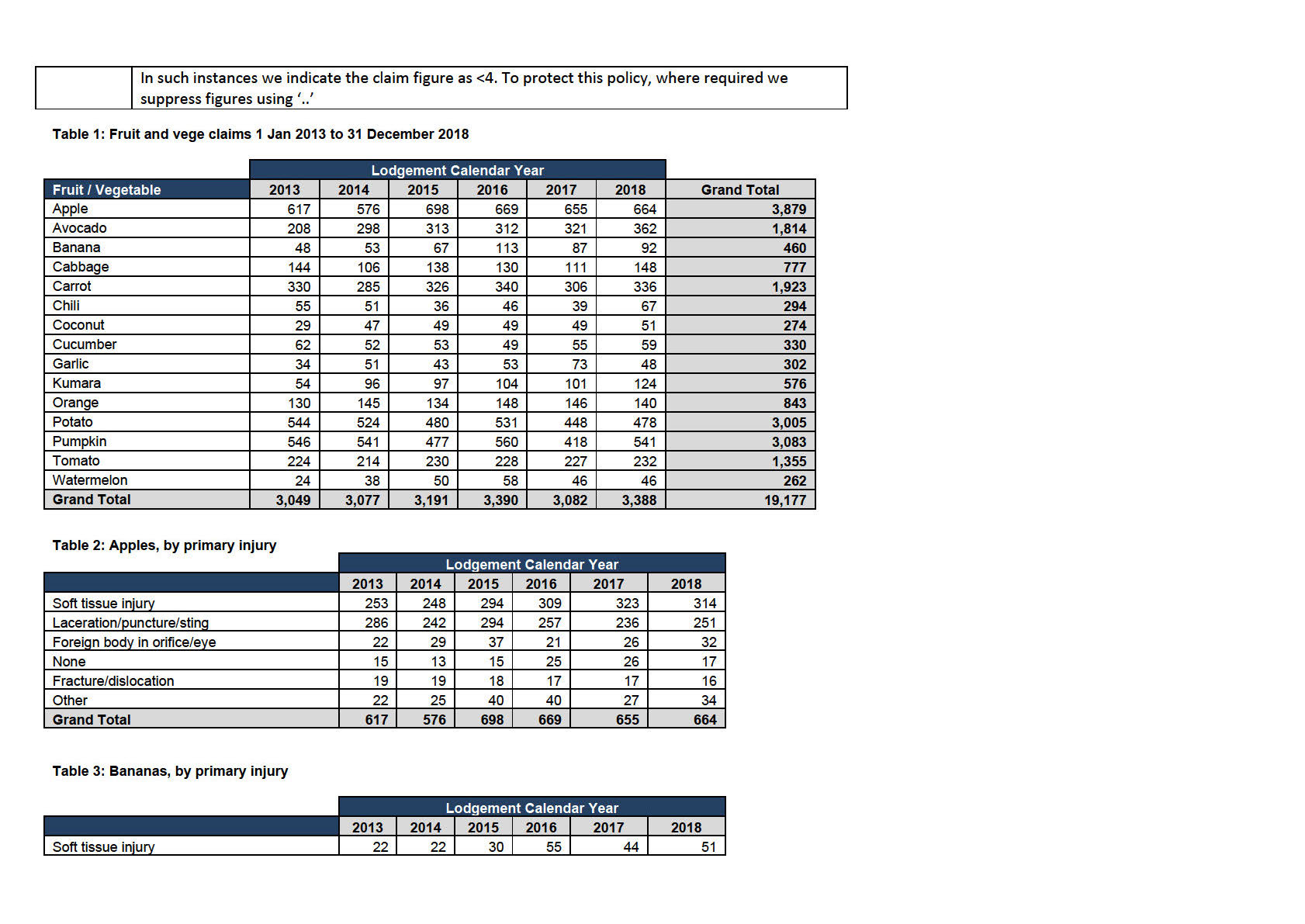
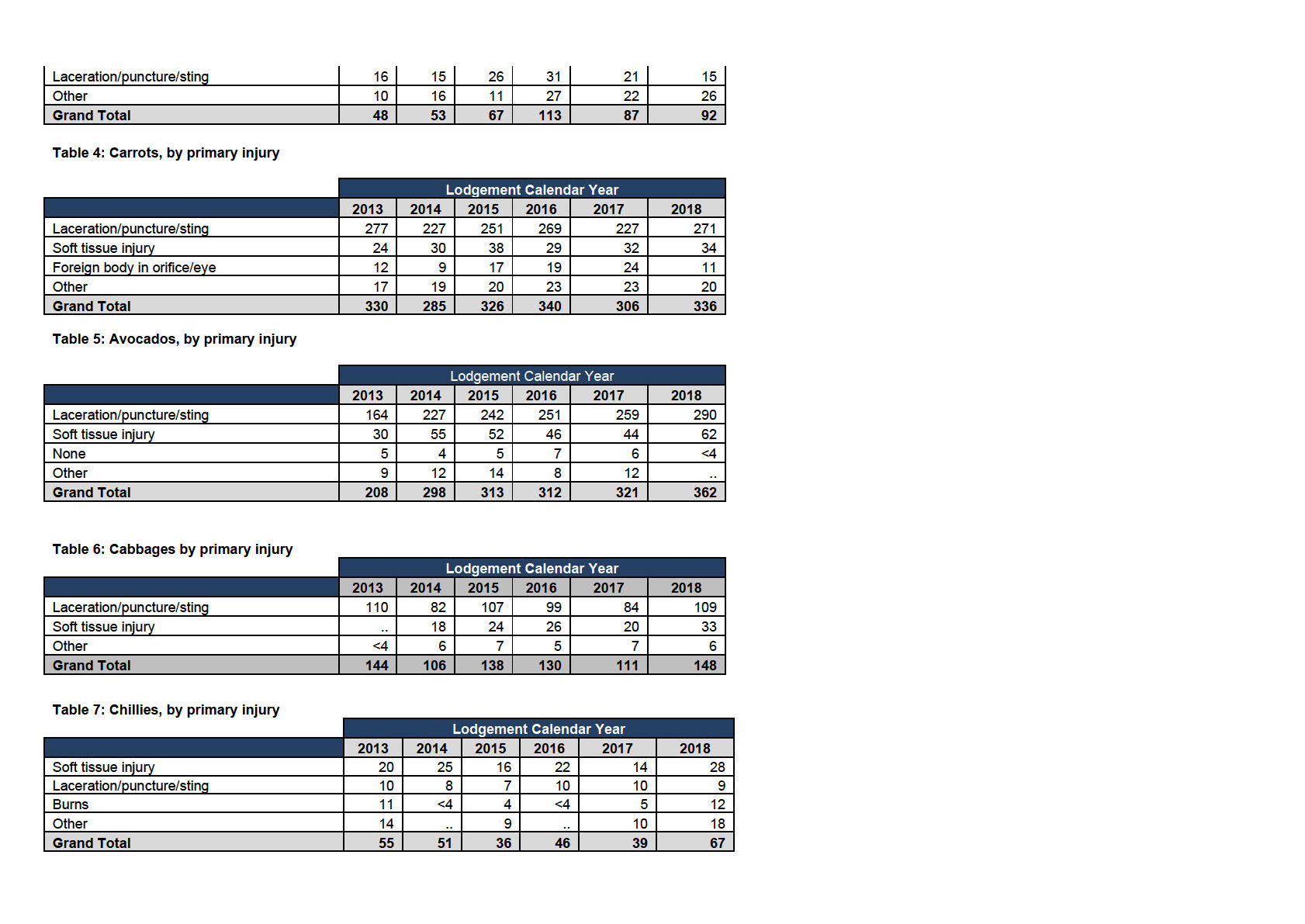
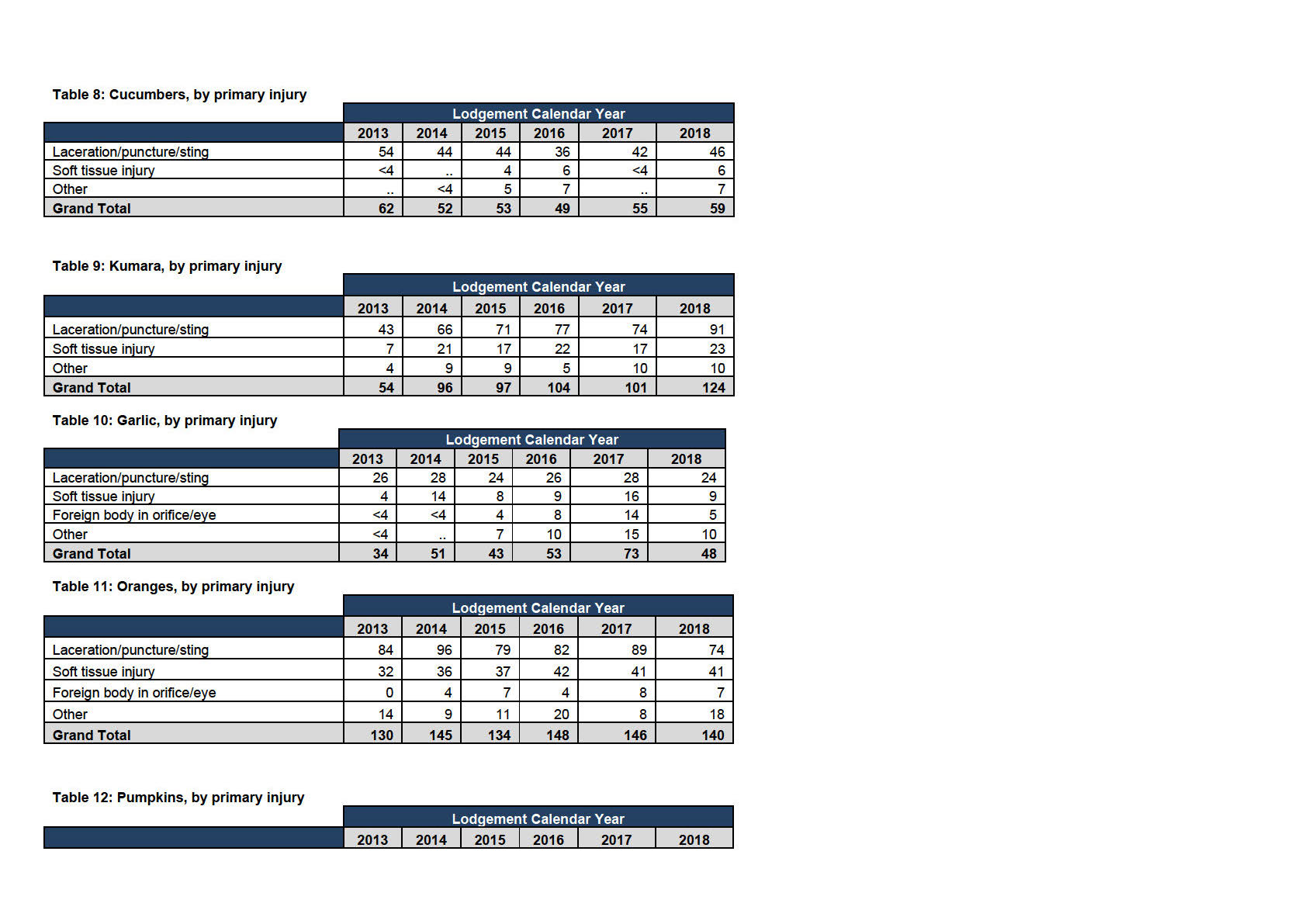

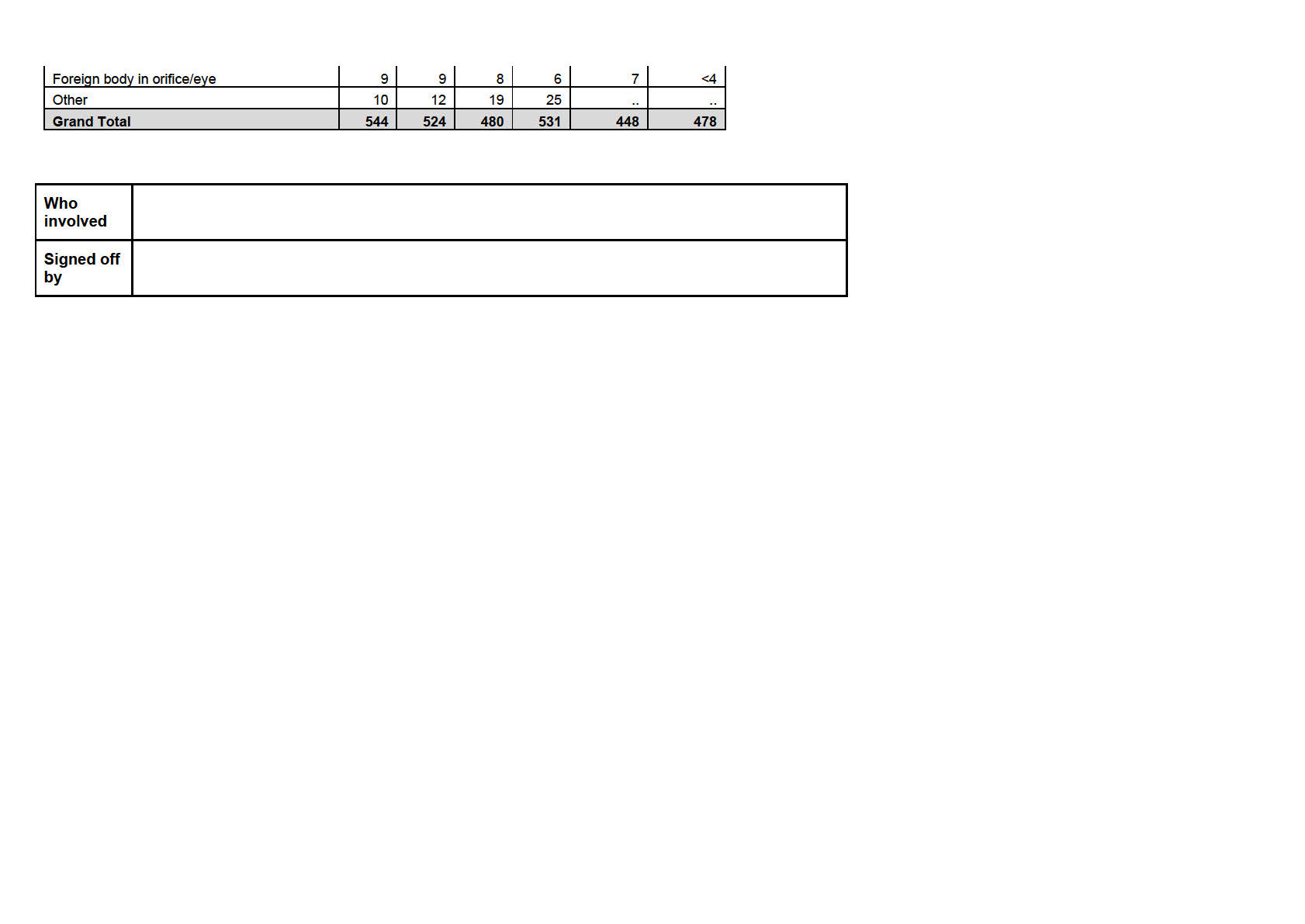
Media enquiry
Date
1 March 2021
Reporter
Chris Bond
From
MORE FM
Contact
Bondy [email address]
Timeframe 12 March 2021
Out of
Request
Hey scope
Hope you are doing well mate.
Can you please help with some data on injuries for preparing and consuming food.
Thanks in advance
Redmine #
Response
Hi Bondy,
I hope you are doing well.
Sorry it has taken me a few days to come back to you, this was a complicated request for our
Analytics team.
There is some variance in how people fill in their ACC Claim form so this is not a definitive list, but
some of the leading food-related injuries from cuts, burn and other injuries.
Our Analytics team have added this note: "Accident description searches allow for some spelling
variation.
Key word searches have been prioritised in the order on the notes page, eg. a claim which mentions
'coffee' will not be included in soup claims, even where 'coffee' is mentioned.
Please note that key word searches may return some claims which aren't relevant to the request.
For example, a claim which mentions 'avocado' may refer to fruit picking, and a claim which
mentions 'fish' may refer to a live animal."
Also: Please note that there were fewer than 4 claims which mentioned 'chicken' with a read code /
ICD9 code / ICD10 code that referred to salmonel a or food poisoning, with associated costs less
than $100.
I have summarised some of the data below for you.
1. Burn related claims
•
Hot drinks were one of the highest causes of
burn-related ACC claims. There were 7,179
burn related injury claims from hot drinks in the last five years.
• The cost over five years to help these people recover was $2.8m. The 1382 hot drink related
injuries in 2020 came at a cost of $632,957, the highest cost for the past five years.
•
Soup also featured in a high number of burn related injuries. There were 1,254 soup related
burn injuries in the past five years. These injuries came at a cost of $541k over the past five
years. Pies, chips and pizza were the next highest for burn related injuries.
2. Cutting related claims
•
For cutting injuries (while preparing food)
Fish was the No 1 item on this list. There were
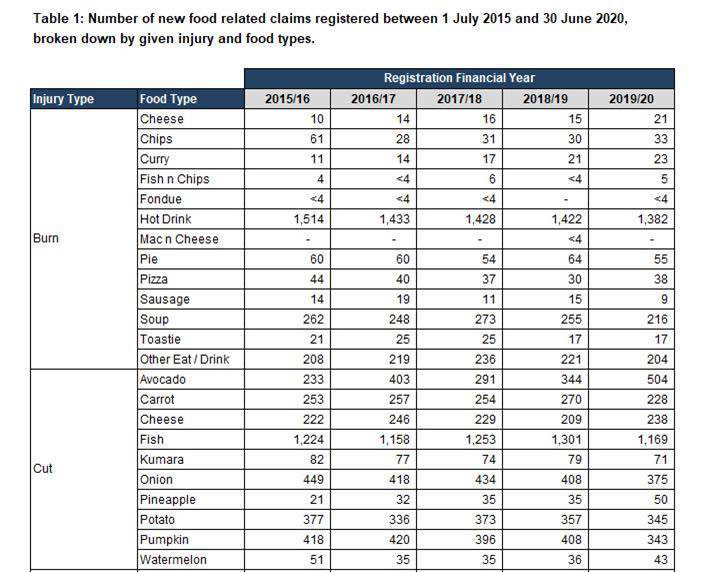
6105 cutting related injuries with fish over the past five years at a cost of $2.3m
• Pumpkin was the leading vegetable for causing injury while preparing food. There were 1985
injuries relating to cutting pumpkins over five years. These cost $500k with the 2020 cost
the highest from this period ($159k)
•
Potato was the second for vegetables with 1788 cutting related injuries over the past five
years, which cost $357, 934 – the highest cost of the past five years.
• Avocado was the highest fruit for cutting related injuries. There were 1775 avocado cutting
related injuries over the past five years which cost $1.4m.
3. Other related claims
• In terms of
‘Other’ injuries – this will include all claims besides those with a primary
diagnosis of burn or laceration / puncture / sting. So these could be soft tissue injuries,
fractures etc., and may include claims that just mention ‘coffee’ or other food in passing,
even if not directly related to the injury.
• Over the past five years there have been a total of 26, 248 injuries involving
hot drinks that
were not burns. These injuries came at a cost of $19.5m with the 2020 cost ($4.5m) the
highest in this period.
•
Fish were the second highest on this list. There were 11,232 injuries that mention fish in
their description in the last five years. These came at a cost of $16.5m.
•
Chicken was the third highest on this list with 8148 injuries where ‘chicken’ was mentioned.
These came at a cost of $9.2m.
Injury Prevention advice
Kirsten Malpas, ACC Injury Prevention leader, says “Most injuries are preventable if you slow down
and take a moment to assess the risks”.
I have compiled the fol owing data for you.
Table 1: Number of new food related claims registered between 1 July 2015 and 30 June 2020,
broken down by given injury and food types.
Table 2: Number of active food related claims with a payment made between 1 July 2015 and 30
June 2020, broken down by given injury and food types.
Table 3: Active costs (excluding GST) for food related claims with a payment made between 1 July
2015 and 30 June 2020, broken down by given injury and food
types.
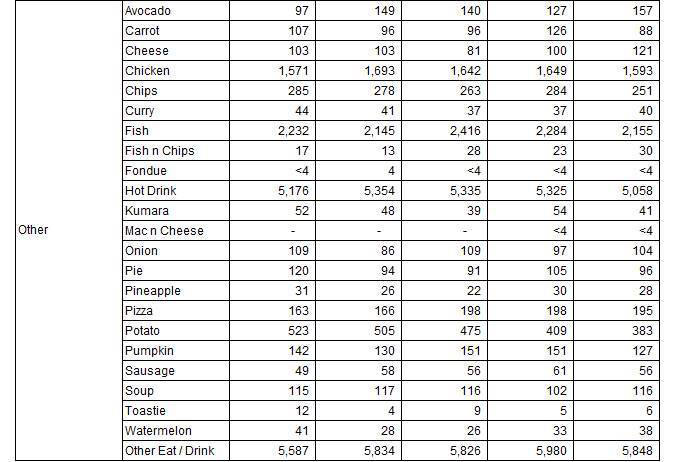
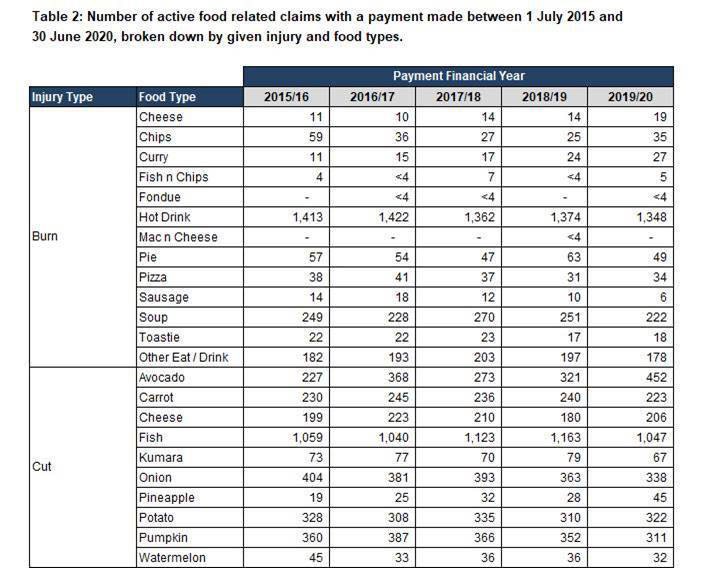

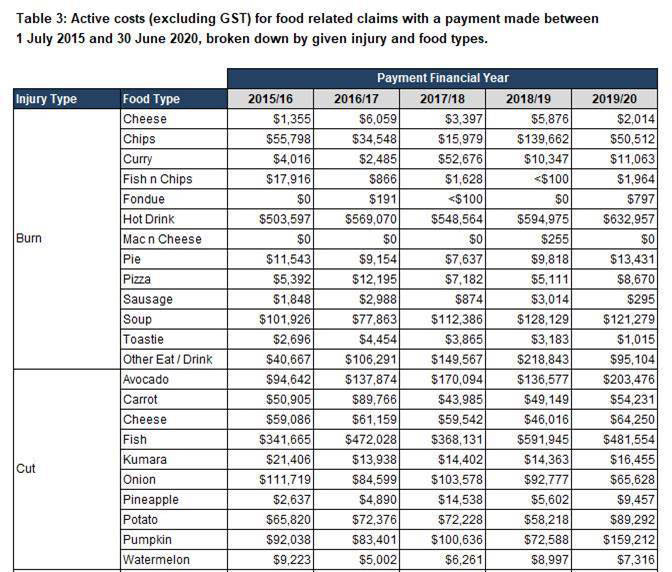
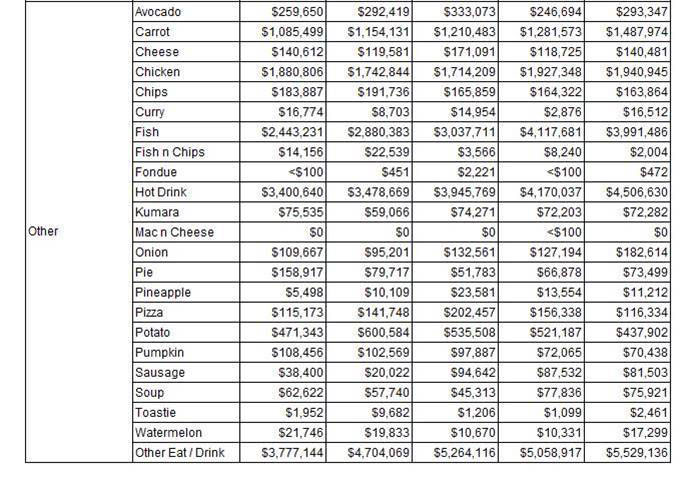 Notes on the data
Notes on the data
• As a no-fault scheme, ACC relies on information recorded by claimants on a claim form
fol owing an injury. To answer your request, we used a free-text search for the key words;
• The data have been extracted based on the following criteria: The claim registration /
payment date is between 1 July 2015 and 30 June 2020. The claim cover decision is equal to
'Accept'.
• For hot drink related injuries the accident description contains 'coffee', 'hot chocolate', 'tea'
or 'milo'.
• For soup related injuries the accident description contains 'soup'
• For pie related injuries the accident description contains 'pie'.
• For toastie related injuries the accident description contains 'toastie' or 'toasted
sandwich'.
• For curry related injuries the accident description contains 'curry'.
• For sausage related injuries the accident description contains 'sausage'.
• For fish and chip related injuries the accident description contains 'fish and chips'.
• For chip related injuries the accident description contains 'chips'.
• For fondue related injuries the accident description contains 'fondue'.
• For macaroni and cheese related injuries the accident description contains 'macaroni and
cheese' or 'mac and cheese'.
• For pizza related injuries the accident description contains 'pizza'.
• For avocado related injuries the accident description contains 'avocado'.
• For watermelon related injuries the accident description contains 'watermelon'.
• For pineapple related injuries the accident description contains 'pineapple'.
• For pumpkin related injuries the accident description contains 'pumpkin'.
• For kumara related injuries the accident description contains 'kumara'.
• For potato related injuries the accident description contains 'potato'.
• For onion related injuries the accident description contains 'onion'.
• For carrot related injuries the accident description contains 'carrot'.
• For cheese related injuries the accident description contains 'cheese'.
• For chicken related injuries the accident description contains 'chicken'.
• For fish related injuries the accident description contains 'fish' but does not contain
'fishing'.
• For other eating / drinking related injuries the accident description contains 'drink' or
'eat'.
• For burn claims the primary diagnosis is equal to 'Burns (Burn, Corrosive Injury,
Scald)'.
• For cut claims the primary diagnosis is equal to 'Infected/ Non-Infected Laceration, Puncture
Wound, Sting'.
• For food poisoning claims the read code / ICD9 code / ICD10 code contains 'salmonella' or
'food poison'.
• We do not provide exact figures where there are fewer than four claims for a particular
injury, time frame, or region etc, or costs under $100. This is to avoid inadvertently
identifying a client, and thereby breaching their privacy. In such instances we indicate the
claim figure as <4 or <$100. To protect this policy, where required we suppress figures using
‘..’
• All figures are GST exclusive, and cover all treatment and entitlements incurred for that
claim, except the cost of emergency treatment at public hospitals, which we bulk-fund
through our $530 million contribution to Public Health Acute Services (PHAS), and costs are
not allocated to individual claims.
• An active claim is one where a payment has been made against it in the year shown,
regardless of the year in which the claim was lodged. Some claims have ongoing costs, so in
any given year it’s likely we’ll be paying costs on claims lodged in previous years. That
means, for example, that the amount we have paid out in 2017 wil include some payments
relating to injuries suffered in 2016 or earlier, as well as those suffered in that year.
ENDS
Out of scope
Who
AnR
involved






















